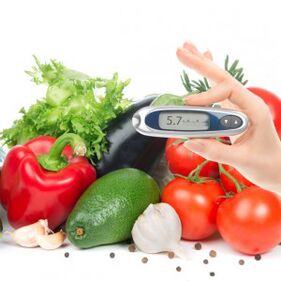
The diabetes diet is one way to control the disease to prevent the development of acute and chronic complications. The most important task of therapeutic measures is to normalize metabolic processes in the body by optimizing blood sugar levels to the maximum allowable value.
Adherence to a low-carbohydrate diet and well-chosen medication are key to patient well-being.
If you do not start treating the disease on time, diabetes mellitus will complicate your kidneys, nervous system, blood vessels, eyes and heart.
Etiology and pathogenesis
Today, 4% of the world's population suffers from this disease. According to the WHO, 8, 640 people with diabetes die every day worldwide, and 3 million people die each year. This figure is many times higher than the mortality rates for hepatitis and AIDS. According to the International Diabetes Association, the number of carriers of this disease as of 2014 is 285 million. However, it is projected to reach 2030. their number could increase to 438 million.
Etiology of the disease:
- obesity;
- hereditary predisposition;
- viral infections (influenza, tonsillitis) that cause damage to the islet device and latent diabetes;
- mental / physical trauma;
- vascular, autoimmune disorders.
External factors contributing to diabetes:
- prolonged mental stress, stress, fear, fear;
- Eating foods that contain too many carbohydrates and saturated sugars;
- prolonged overeating.
Symptoms of diabetes in men and women:
- weakness;
- polyuria (increase in urine volume up to 8 l / day);
- weight loss;
- hair loss;
- drowsiness;
- frequent urination;
- intense thirst;
- decreased libido, potency;
- itching of feet, palms, perineum;
- increased appetite;
- wounds do not heal well;
- decreased visual acuity;
- Acetone smells from the mouth.
If you notice any signs of a disease, see a doctor immediately, as the effectiveness of your diabetes treatment depends directly on the speed at which the first symptoms of the disease are detected, the conclusion of the diagnosis, and medication. Keep in mind that the disease is easier to treat in the early stages.
Disease classification and the role of nutrition

After drug therapy, the primary role should be attributed to the patient's diet.
The types of diets depend on the stage of pancreatic depression, the mechanism of its manifestation, and the method of treatment.
Degrees of the disease
- Type 1 diabetes. It is a severe autoimmune disease associated with impaired glucose metabolism. In this case, the pancreas does not produce at all or produces too little insulin to maintain vital functions in the body.
- Type 2 diabetes. Often, this form of the disease develops in people with reduced mobility who weigh more than 15% of their total weight.
- Gestational diabetes. This type of diabetes develops in 4% of women during pregnancy, more often in the second trimester. Unlike the first two types of disease, in most cases it disappears immediately after the birth of the child, but sometimes it can turn into a second type of diabetes. . . .
Less common forms (variants) of diabetes that occur in 1% of the world’s population are prediabetic, latent, neurogenic, renal, steroid, bronchial, MODY.
Diabetes Diet Types
Insulin injections, hypoglycemic medications, and physical activity are important to achieve positive dynamics in the treatment of the disease. However, some doctors (A. Bronstein, E. Malysheva, V. Kononov) say that a proper diet plays a fundamental role.
Types of nutrition programs

- A carbohydrate-free diet is a technique based on consuming large amounts of complex carbohydrates from vegetables and fruits and excluding foods that contain simple carbohydrates.
- Protein content in diabetes. This diet is based on the principle of minimizing the consumption of carbohydrates and fats by increasing the protein in the diet. The main focus of the methodology is the replacement of meat with lean fish, poultry and fermented dairy products.
- A low carb diet to put together a menu for type 1. 2 diabetics.
- Buckwheat diet. Regular consumption of this product has a beneficial effect on the body: it lowers the level of "bad" cholesterol and saturates it with iron, rutin, calcium, magnesium, fiber, iodine, B vitamins. A buckwheat diet in diabetes helps minimize the likelihood of macrovascular complications and ulcers.
- A diet to prevent diabetes aims to reduce the risk of developing pancreatic dysfunction.
With the appearance of exacerbations of the cardiovascular system and blood vessels, diet 10 is used in addition to diabetes. Its peculiarity is to reduce the consumption of fluids, salt, fats, carbohydrates, as these substances overload the liver, kidneys and irritate the nervous system.
Let’s examine in detail what diet is needed for diabetes mellitus, recipes for foods that should be consumed during the dietary period.
Carbohydrate counting
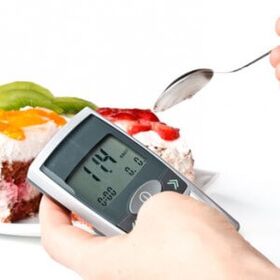
When detecting diabetes mellitus, the right balance of carbohydrate and glucose-lowering intake is important. A universal parameter called the bread unit is used to calculate the caloric content of the products. However, 1 XE (10 to 13 g of pure carbohydrate) raises glucose to 2. 77 mmol / l and requires 1. 4 units of insulin to absorb. Because the injection is given before the start of a meal, it is important to plan a meal dose in advance.
A meal should have a carbohydrate content of 4-6 bread units. The frequency and timing of meals depends directly on the type of sugar-lowering medication.
Quantity of product corresponding to 1XE:
- sugar - 1 tbsp. ;
- honey - 1 tbsp. l. ;
- spaghetti - 1, 5 tbsp. ;
- juices - 150 ml;
- ice cream - 60 g;
- fresh water with gas - 180 ml;
- bread (rye, white, black) - 25 g;
- pancakes or pancakes - 1 piece;
- pasta - 25 g; melon - 300 g;
- porridge (oats, buckwheat, wheat) - 2 tbsp. l. cereals;
- sausage - 200 g;
- kefir, fermented fried milk, milk - 250 ml;
- mashed potatoes - 100 g;
- apple - 100 g;
- legumes (peas, beans) - 5 tbsp. l. ; kiwi - 150 g; pear - 90 g;
- orange - 100 g;
- berries - 150 g; plums - 100 g; peaches - 150 g;
- watermelon - 400 g;
- dried fruit (prunes, raisins, dried apricots) - 20 g.
The carbohydrate saturation of a diabetic's daily diet should not exceed 17 bread units (2000 kcal).
In addition to counting saccharides, it is important that patients with pancreatic dysfunction carefully choose food to eat based on prohibited and permitted ingredients.
| Product Category | Enabled | Available: limited quantity |
Forbidden Food |
|---|---|---|---|
| Bakery Products | Aborted | Wheat, wholemeal, rye, second-class flour bakery ware | Puff pastry, pasta |
| Meat and Poultry | - | Lean veal, lamb, chicken, turkey, rabbit, cooked tongue diet sausages | Fatty pork, beef, goose, duck, canned, sausage, bacon, smoked sausage |
| First Courses | Borsch, cabbage soup, fish soup, soups: mushrooms, fish, beets | Low fat solyanka | Pasta soups, fatty broths, traditional kharcho |
| Fish | Lean fish fillet | Mussels, squid, shrimp, oysters, crab, salmonids (trout, salmon, salmon) | Eel, caviar, canned oil, herring fish (sprat, sprat, herring), sturgeon (starfish shell, beluga, shell) |
| Dairy, fermented dairy | Milk, kefir, unsalted cheese 25-30% | Homemade yogurt, milk 0%, feta cheese, cottage cheese 5%, cottage cheese, fermented fried milk | Sour cream, cheese 50-60%, salted cheese, glazed cottage cheese, butter, condensed milk, cream |
| Porridge | Buckwheat, pearl barley, oatmeal, barley, millet | - | Groats, brown rice, pasta |
| Vegetables | Carrots, cabbage (all kinds), beets, pumpkins, tomatoes, zucchini, eggplant, onions, turnips, radishes, mushrooms, cucumbers, fresh leafy vegetables, peppers | Corn, boiled potatoes, fresh legumes | French fries, fried vegetables, pickled and salted vegetables |
| Fruits, Berries | Quince, lemon, blueberry, pear | Plums, apples, peaches, oranges, cherries, blueberries, watermelons, currants, raspberries | Grapes, figs, dates, raisins, bananas |
| Desserts | Fruit salads | Sambuca, compotes, sweetening foam, fruit jelly, green cocktails with honey (1 dec. ) | Ice cream, cakes, greasy cookies, pastries, jam, puddings, sweets, milk chocolate with nuts |
| Sauces and condiments | Mustard, pepper, horseradish, tomato juice, cinnamon, dry spices and herbs | Homemade Mayonnaise | Ketchup, roasted vegetables, purchased sauce |
| Drinks | Tea, cocoa, ground coffee (without sugar and cream), rosehip and raspberry decoction, unsweetened fruit nectars, sour berry drinks | Natural vegetable juice (diluted) | Sugar lemonades, kvass, sweet drinks, alcohol |
| Fats | - | Vegetable oils (flaxseed, corn, sunflower olives), unsalted butter | Lard, twenty fats |
After converting carbohydrates into units of bread, it is important to determine the amount of insulin needed to use your postprandial blood sugar. Adherence to this recommendation will help you avoid life-threatening conditions — hyper- and hypoglycemia.
Diet for Grade 1 Diabetes
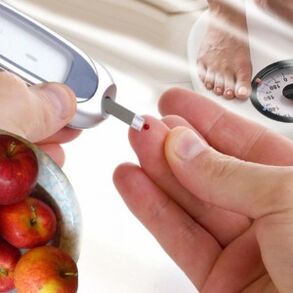
The type 1 diabetes diet is based on strict control of blood sugar levels (3. 5… 5, 5 mmol / l).
Take into account the specifics of food intake, allowing the level to be maintained within established limits.
- The maximum daily caloric content of foods (total daily) is 2000 kcal.
- Fragmented nutrition (at least five times).
- Clear pure sucrose from the menu to lower your blood sugar.
- Distribute your main portion of carbs for breakfast and lunch.
- Do not eat at night.
- Avoid consuming easily digestible carbohydrates: baked goods, honey, jam, canned food.
- Use a natural sweetener as a sweetener.
- Monitoring the quality and "naturalness" of products.
- Set the schedule of insulin treatment with meals (long-acting medicine is given before a meal, shortly after a meal).
- Calculate the number of units of bread to take into account the amount of carbohydrates consumed per day. You should eat no more than 8 XEs per meal.
In the presence of diseases of the gastrointestinal tract (inflammation of the pancreas, ulcers, gastritis), the diabetes mellitus diet prohibits the intake of products such as: pickles, smoked meats, rich broths, coffee, carbonated drinks, alcohol, mushrooms, canned food, which stimulate excessive secretion of enzymes because they affect the rate and level of carbohydrate absorption.
Allowed Type 1 Diabetic Foods:
- yeast-free baked goods (lavash);
- berries, fruits (plums, cherries, lemons, apples, pears, oranges);
- soy products (tofu, milk);
- cereals (pearl barley, oatmeal, buckwheat porridge);
- vegetarian puree;
- drinks (lightly carbonated mineral water, berry foam, dried fruit compote);
- vegetables (onions, zucchini, peppers, beets, carrots);
- nuts (not roasted);
- weak coffee, unsweetened green / black / fruit teas.
Don't eat:
- rich soups, broths;
- pasta, flour products;
- sweets (cakes, pastries, sweets, chocolate, muffins);
- fast food, semi-finished products;
- alcoholic beverages (consumption of red dessert wine is strictly forbidden);
- sour, smoked, spicy foods;
- fatty meats (pork, lamb, duck), fish (mackerel).
The daily caloric intake of an obese patient with this diet is between 1200-1400 kcal with insulin. Without having to get rid of extra pounds, food rations can be increased.
A week-long diet for overweight insulin addicts
Day 1
- breakfast - bread - 1 slice, porridge - 170 g, green tea, cheese - 40 g;
- second breakfast - pear - 0, 5 pcs, young cheese - 60 g;
- lunch - beets - 250 g, braised cabbage - 200 g, vegetable salad - 100 g, braised slices - 100 g, lavash;
- afternoon tea - rosehip broth, cottage cheese - 100 g, fruit jelly - 100 g;
- dinner - cauliflower zrazy - 100 g, vegetable salad - 150 g;
- before going to bed - milk - 200 ml.
Day 2
- breakfast - boiled veal - 50 g, green tea, omelette, tomatoes - 1 pc. , bread - 1 slice;
- second breakfast - grapefruit or orange - 1 piece, pistachios - 50 g;
- lunch - chicken breast - 100 g, vegetable salad - 150 g, pumpkin porridge - 150 g;
- afternoon tea - grapefruit - 1 pc. , kefir - 200 ml. ;
- dinner - boiled fish - 100 g, braised cabbage - 200 g;
- Bedtime - Unsweetened Biscuits - 50g
Day 3
- breakfast - lavash, weak coffee without sugar, cabbage rolls with meat - 200 g;
- second breakfast - strawberries - 120 g, yogurt - 200 ml;
- lunch - pasta - 100 g, vegetable salad - 100 g, steamed fish - 100 g;
- afternoon tea - orange - 1 pc. , dried fruit decoction;
- dinner - cottage cheese with casserole pears - 250 g;
- before going to bed - kefir.
Day 4
- breakfast - porridge - 200 g, green tea, cheese - 70 g boiled eggs - 1 pc;
- second breakfast - toast with cheese, turkey fillet;
- lunch - with steamed zucchini meat - 200 g, vegetarian puree soup - 150 g, bread - 2 pcs. ;
- afternoon tea - lean cookies - 15 g, unsweetened black tea;
- dinner - green beans - 200 g, boiled chicken fillet - 150 g, rosehip broth;
- before going to bed - dry diet bread - 3 pcs.
Day 5
- breakfast - low-fat cottage cheese (up to 5%) - 150 g, kefir - 200 ml;
- second breakfast - pumpkin seeds - 2 tbsp, raisins - 3 tbsp;
- lunch - baked potatoes - 100 g, vegetable salad - 150 g, compote without sugar - 100 g;
- afternoon snack - unsweetened fruit tea, roasted pumpkin - 150 g;
- dinner - vegetable salad - 200 g, steamed slices - 100 g or pancakes with blueberries on rye flour - 250 g;
- before going to bed - kefir 1%.
Day 6
- breakfast - boiled eggs - 1 piece, fruit tea, light salted salmon - 30 g;
- second breakfast - cottage cheese - 150 g, carrots - 1 pc;
- lunch - green beets - 250 g, cabbage rolls with brown rice and carrots - 170 g; pita;
- afternoon tea - kefir - 150 ml. , bread - 2 pcs;
- dinner - fresh peas - 100 g, boiled chicken fillet - 100 g, steamed eggplant - 150 g;
- before going to bed - dry biscuits - 50 g.
Day 7
- breakfast - ham - 50 g, buckwheat porridge - 200 g, green tea;
- second breakfast - salad of tuna, cucumber, cherry tomatoes, wholemeal rye bread - 150 g;
- lunch - steamed zucchini with carrots - 100 g, cabbage soup - 250 g, bread - 1 slice, chicken slice - 50 g;
- afternoon tea - cottage cheese - 100 g, apricots or plums - 4 pieces;
- dinner - squid with onions - 150 g, dried fruit compote;
- before going to bed - milk - 200 ml.
A low carb diet for diabetics is a strictly balanced diet for the patient to keep the sugar in the normal range and for systematic weight loss.
Type 2 Diabetes Diet

Basics of a healthy diet:
- replace refined carbohydrates with sweeteners;
- the BZHU ratio should be 20%: 30%: 50%;
- can reduce your consumption of animal fats by up to 50%;
The caloric content of the daily diet depends on the patient's energy intake and body weight.
The9th Diabetes Diet or Table 9 is a balanced program for moderate to moderately obese diabetics. In addition, the patient's diet consists of proteins (100 g), carbohydrates (320 g), fats (80 g), 30% of which are unsaturated triglycerides.
The type 2 diabetes diet is almost identical to the nutrition program of people who monitor their health:
- divide the total amount of food for the day into 5 meals: 2 snacks at 1-2XE, 3 main meals at 5-8XE;
- don't miss breakfast;
- maximum break between meals - 4 hours;
- last meal in the evening - 1, 5 hours before bedtime;
- It is recommended to eat vegetable salad, fruit, freshly squeezed fruit juice, dried fruit soup, kefir, milk, green or fruit tea, unsweetened biscuits (crackers), bread.
Daily diet for type 2 diabetes
Day 1
- breakfast - asparagus - 100g. , scrambled eggs from 3-4 quail eggs;
- second breakfast - walnut, squid, apple salad - 200 g;
- lunch - fried eggplant stuffed with pomegranate, walnuts - 100 g, beets - 250 g;
- afternoon tea - avocado and cocoa ice cream - 100 g;
- Dinner - salmon steak with radish sauce - 200 g.
Day 2
- breakfast - yogurt, oatmeal - 200 g (you can use stevia or agave nectar as a sweetener), apples - 1 pc;
- second breakfast - fruit smoothies (in a blender grind 80 g of cherries, strawberries, melons and 4 ice cubes each);
- lunch - roast veal - 150 g, stew with vegetables - 200 g;
- afternoon snack - cottage cheese and pear casserole - 150 g;
- dinner - mixed vegetables - 200 g, avocado - half the fruit.
Day 3
- breakfast - fried egg with the addition of low-fat cheese, basil and tomatoes;
- second breakfast - "steamy" vegetables - 100 g, hummus - 100 g;
- lunch - vegetarian puree soup - 200 g, green peas - 50 g chicken slices - 150 g;
- afternoon tea - pear - 1 pc. , almonds - 50 g;
- Dinner - salmon - 150 g, yogurt, spinach.
Day 4
- breakfast - fried fruits (apples, plums, cherries) in agave nectar - 200 g;
- second breakfast - sandwich with tuna and salad;
- lunch - beef steak - 150 g, boiled cauliflower - 200 g, tomato salad, arugula, parmesan - 100 g;
- afternoon tea - fruit and berry dessert (cut mango, kiwi, strawberry, combine with snow, pour orange juice and freeze) - 150 g;
- dinner - broccoli rolls - 200 g.
Day 5
- breakfast - orange - 1 pc; fruit tea, low-fat cheese - 30 g, bread - 2 pcs. ;
- second breakfast - beet salad with walnuts - 200 g;
- lunch - rice - 200 g, salmon, steamed - 150 g, grapefruit - 1 pc;
- afternoon tea - berries with whipped cream 10% - 150 g;
- dinner - rosehip broth with squid onions - 200 g.
Day 6
- breakfast - carrots and cottage cheese soup - 200 g;
- second breakfast - cauliflower zrazy - 100 g;
- lunch - tangerine salad, chicken breast, arugula - 200 g, dried fruit compote, vegetable pepper - 200 ml;
- afternoon tea - kiwi, raspberry foam - 200 ml. ;
- dinner - steamed cod with carrots - 200 g, kefir.
Day 7
- breakfast - baked apples stuffed with oatmeal, walnuts, raisins - 1 pc;
- second breakfast - kohlrabi, celery, pear fruit and vegetable salad - 200 g, shrimp - 100 g;
- lunch - polenta - 200 g, greens, cooked hake - 200 g, kiwi - 1 pc;
- afternoon tea - with strawberry mascarpone - 100 g;
- dinner - cucumber salad with onions, spinach - 250 g, green tea.
Depending on the course of the disease, changes can be made in the patient menu.
Keep in mind that the above diet is not a universal nutrition system for all diabetics, so it is important to monitor your well-being. If this worsens, “problematic” foods should be excluded from the menu.
Gestational diabetes diet
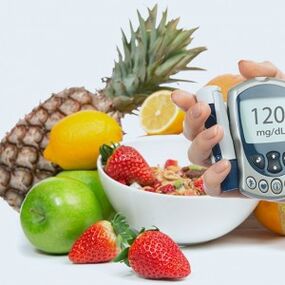
In some cases, the pancreas is damaged in the body of the expectant mother, resulting in gestational diabetes. In most cases, this condition can be easily controlled with proper nutrition.
Diabetes diet during pregnancy
- Remove foods containing sugar, pastries, baked goods, semolina, sweet fruits, sweeteners from your diet.
- Balances the daily menu. The daily norm for carbohydrates is 50%, proteins - 30%, fats - 15-20%. However, Malysheva’s diabetic diet minimizes the amount of food containing plant and animal triglycerides (5-10%).
- Note the drinking system - 1, 5-2 liters of water per day.
- Enrich your daily diet with starchy (cereals, rye bread, brown rice, legumes, sweet potatoes, Jerusalem artichokes, radishes, beets) and fermented dairy products.
- Snack for fresh fruit.
- Divide the daily meal into 3 main meals (breakfast, lunch, dinner) and 2 snacks (lunch, afternoon snack).
- Enrich your daily diet with multivitamin complexes for pregnant women.
- Reduce sugar with folk remedies with celery roots, linden flowers, blueberry leaves, purple buds, bean pods.
- Limits caffeine intake. The permissible norm for alkaloids is 2 servings of coffee or tea.
The optimal caloric intake of a pregnant woman's daily diet is 2000 - 2500 kcal. However, a carbohydrate-free diet is contraindicated in gestational diabetes.
Recommended menu for expectant mothers with high blood sugar
- breakfast - millet porridge - 150 g, fruit tea, rye bread - 20 g;
- second breakfast - dried whole wheat buns - 50 g, unsalted cheese 17% - 20 g, apples - 1 pc;
- lunch - buckwheat porridge - 100 g, cabbage mixture, Jerusalem artichokes, cucumbers - 150 g, beef stew - 70 g;
- afternoon tea - cottage cheese 5% - 100 g, unsweetened biscuits - 2 pieces, orange - 1 piece;
- dinner - boiled chicken fillet - 60 g, vegetable garnish (carrots, cabbage, peppers) - 100 g, tomato juice - 180 ml, bread - 2 pcs. ;
- 3 hours before bedtime - kefir / yogurt - 200 ml.
In addition to following a special diet, patients with gestational diabetes show walking (40 minutes a day) and moderate physical activity (gymnastics, water exercises).
Diet for Insulin-Dependent Diabetes in Children
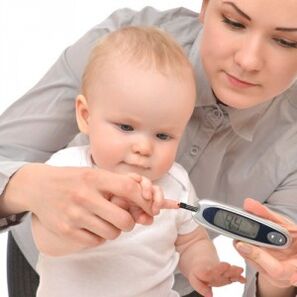
Diabetes is much more difficult to carry in childhood and adolescence than in adults. A child’s genetic predisposition, stress, and poor nutrition are major causes of autoimmune disease.
In 80% of cases, children are diagnosed with insulin-dependent diabetes (type 1). Early diagnosis, immediate treatment, and strict adherence to a special diet will help prevent the consequences of the disease.
Diabetes diet in children
- Excludes sugar, soda, confectionery, wheat flour, baked goods, baked goods, baked goods from the menu.
- Enrich your daily menu with unsweetened fruits, vegetables and herbs (unlimited). Prohibited - grapes, bananas, raisins, dates, persimmons, figs.
- Use natural sugar substitutes.
- Divide your daily food intake into 6 meals. However, it is important to eat food at regular intervals. Tolerances for a child's diet are 15 to 20 minutes.
- Meals should be taken after 15 minutes. after insulin administration and 2 hours after injection.
- If you can't eat at the specified time, you can eat bread, pears, nuts, cheese sandwich or apple as a bite. Under no circumstances should you starve to death.
- Taking a slice of chocolate immediately can prevent hypoglycemic attacks. Therefore, the adult accompanying the child should always have a sweet product.
- Enrich your child's daily diet with fermented dairy products.
- Calculate your daily fructose intake. The amount of sugar substitute depends directly on the age of the child and the nature of the course of the disease.
To lower your blood sugar, it is recommended that your child cook blueberries, nettles, corn stalks, mint leaves, barberry branches, bean pods, Jerusalem artichokes, ginseng and eleutherococcus.
So the diet of diabetics plays an important role as the well-being and life of the patient depends on the correctness of the composition. It is therefore important to take the preparation and adherence to the diet very seriously and carefully, otherwise negligence can have tragic consequences.




























